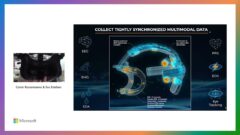Design and Evaluation of Interaction Models for Multi-touch Mice
Adding multi-touch sensing to the surface of a mouse has the potential to substantially increase the number of interactions available to the user. However, harnessing this increased bandwidth is challenging, since the user must perform multi-touch interactions while holding the device and using it as a regular mouse. In this paper we describe the design challenges and formalize the design space of multi-touch mice interactions. From our design space categories we synthesize four interaction models which enable the use of both multi-touch and mouse interactions on the same device. We describe the results of a controlled user experiment evaluating the performance of these models in a 2D spatial manipulation task typical of touch-based interfaces and compare them to interacting directly on a multi-touch screen and with a regular mouse. We observed that our multi-touch mouse interactions were overall slower than the chosen baselines; however, techniques providing a single focus of interaction and explicit touch activation yielded better performance and higher preferences from our participants. Our results expose the difficulties in designing multitouch mice interactions and define the problem space for future research in making these devices effective.
- Date:
-
-

Andy Wilson
Partner Research Manager
-

Hrvoje Benko
Senior Researcher
-

Ken Hinckley
Senior Principal Research Manager
-
-
Watch Next
-
-
-
Effective Human-AI Decision-Making or Everyone: A Sisyphean Task?
Speakers:- Ujwal Gadiraju
-
-
Galea: The Bridge Between Mixed Reality and Neurotechnology
Speakers:- Eva Esteban,
- Conor Russomanno





